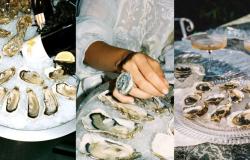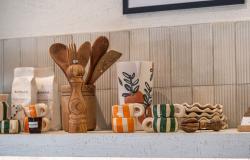Wearing a piece of jewelry, with that little extra soul, brought by an artist-sculptor, painter or architect, means imposing a unique, daring style, detached from any fashion or statutory notion. Journey into a niche jewelry market, far from the more classic codes of Place Vendôme.
The history of artistic jewelry is not new. It has been written for over a century. Picasso, Dali and Calder all tried it in turn. But be careful: this is not about miniaturizing already existing masterpieces. The approach is completely different. Coming from contemporary art, at the head of the MiniMasterpiece gallery since 2012 in Paris, Esther de Beaucé, who saw her mother wearing sculptural pieces throughout her childhood, has made it her specialty. “This niche field allows me to seek collaborations with artists of whom I am a fan. I invite them to think differently. From this momentum projects are born, which I finance and which come to life with the help of the goldsmith. »
Among the encounters between jewelry and contemporary art that she provoked, that with Wang Keping, started in 2021. On the occasion of her second personal jewelry exhibition entitled “Dans la lune”, to be discovered until the 21st December in the gallery, the famous Chinese sculptor presents 5 unique and new jewels in yellow gold, silver and ebony including his first ring. These marvels offer a different relationship with his usually monumental work, that of intimacy and complementarity between the work and his own body. “Some artist jewelry is very bulky but always designed to be portable and comfortable. They are rarely set – the stones are more associated with jewelry and fine jewelry. There is a play on volume from the precious metal,” underlines Esther de Beaucé.
Another advantage? “When a sculptor creates a piece of jewelry, it remains one-off and therefore rare and precious. Even rarer than his work because it is not usual!” But what is the typical gallery client profile? “They are mainly women. They may be collectors of contemporary art, touched to discover another side of the author. There are also people who love jewelry and see something different in it,” continues the editor.
Photo Presse / Galerie MiniMasterpiece
Audacity as a signature
Let's now head to the Ibu Gallery, founded in 2000 by Ibu, a New York artist designer and interior designer of Polish and Ukrainian origin. She inaugurated her place in the heart of the Jardin du Palais Royal, just after having designed jewelry for Chanel's high jewelry, at the request of Karl Lagerfeld… As Alberto Giacometti did before her for Elsa Schiaparelli, in the 1930s. Now in the hands of his daughters and orchestrated by Cyril Ermel, the gallery highlights the creations of Alina Alamorean, Gabriella Kiss, Ted Muehling, Jessica Rose, Jane Schmitt, Annick Tapernoux but also those of Ibu herselfor Jean Grisoni, creator of objects and furniture.
Here, we are talking about designer jewelry. The common thread? Most of the artists represented share a common heritage, that of the Artwear movement (contraction of art and wearporter in English), which is incarnated at the Robert Lee Morris Gallery and which was a hit in the 1970s and 80s in New York. But what differentiates an author's piece of jewelry from a classic piece of jewelry? “It’s a jewel that a woman gives herself, for her audacity. The “Vendôme” jewel is statutory and provides social distancing. Conversely, the artist's jewel is a “conversation piece» in the sense that it arouses curiosity. A woman who carries a mini-sculpture to a dinner wants to create a connection with her environment. Often, she is an independent woman, aged over 45… Sometimes younger, if she has already taken this path, that of asserting a style and not following a fashion,” explains Cyril Ermel.
Photo Presse / IBU Gallery
Transmission object
And what advice would he give to those who are still hesitant? “Dare to cross the gallery doors, without preconceptions. Free yourself! An artistic piece of jewelry must come into harmony with the body, highlighting the beauty of the woman. For that, you have to try it. To see if a dialogue is established between the piece and oneself,” explains the gallery manager, who evokes the Cinderella effect. “Sometimes magic happens. A ring can be tried on by 10 women before this phenomenon occurs. The approach is different from classic jewelry which is designed to appeal to the greatest number of people.” Same advice from Esther de Beaucé, at the MiniMasterpiece gallery. “It’s important to see how a ring sits on the hand. If earrings match the shape of the face. How we live with jewelry. What emerges from it.”
The editor also invites you to listen to your heart. “There is a real, intimate encounter between the person who will wear it and the artist. Even if there is still a notion of investment and sustainability. It’s an object of transmission so you have to be aware of the artist’s standing and the seriousness of the publisher.” But how much does such a part cost? At MiniMasterpiece, prices vary from 400 to 38,000 euros. “These are unique pieces or very limited editions, all signed, numbered and accompanied by certification,” emphasizes Esther de Beaucé. At the Ibu Gallery, which is unveiling new creations for the holidays, you can treat yourself from 1000 euros for earrings signed by Jessica Rose, for example.
Standing the test of time
For those who don't want to take a risk and invest in an artist who has stood the test of time, Diane Venet, an expert in the field, has listed her ideal collection in the book Artist jewelry, from Calder to Koons (Ed. Flammarion). Among the approximately 200 pieces that she has amassed over time, those imagined by Picasso, Kapoor, Indiana, Koons, Braque, Lichtenstein, Vasarely, Stella, Arman, Rauschenberg, César, Dali… To unearth these rare gems, enthusiasts run through the auction rooms. They will be on alert from December 6 to 17 for the new edition of the Joaillerie Paris online sale organized by Christie's.
And for good reason! Among the jewels of the great jewelry houses are hidden, among others, a set of exceptional pieces signed by Jean Vendôme. Died in 2017, this stone and crystal enthusiast, cultivating a taste for colors and materials, stood out, throughout his career, for his modernity of mind and his conceptual and daring approach. An artistic vision which earned him an exhibition in 1968 with Georges Braque at the Delisle gallery. On the occasion of the Paris Joaillerie auction, the illustrator and watercolorist Tatiana de Nicolay designed the scenography of the exhibition, to be discovered at Christie's at 9 avenue Matignon in Paris, from December 12 to 17.
Press Photo / Flammarion
Surrealism and non-conformism
Like Jean Vendôme, certain jewelry designers stand out for their artistic vision of jewelry. This is the case of Adelina Mars, who shakes up classic codes, with non-conformist pieces, which let the materials express themselves. The unexpected frames, sizes and settings, in a play of textures and stones in cold colors and brilliant reflections, give off a bold, slightly rebellious look… If you don't like to be noticed, move on! This audacity is also wonderfully embodied at the heart of the permanent exhibition “Dali Bijoux”, to be discovered in an annex building of the Dalí Theater Museum in Figueres in Spain. The ensemble, produced between 1941 and 1970, perfectly illustrates the various stages of his artistic evolution. In 1999, the Dalí Foundation bought the collection for 900 million pesetas from a Japanese organization! If you can't afford such a treasure, you can always fall back on phone jewelry, from the collaboration between Casetify, the smartphone accessories brand and the Spanish maestro, bringing back to life the iconic Molles Watches or the Bocca Sofa. Are you passionate about surrealism? Also to be discovered until December 21 at the Negropontes Gallery in Paris, a jewelry exhibition celebrates the 100 years of the artistic movement through pieces, each more astonishing than the last. From Walid Akkad's elk-shaped ring to the jewelry sculptures of Agnès Baillon and Éric de Dormael…
Photo Presse / Galerie Negropontes






